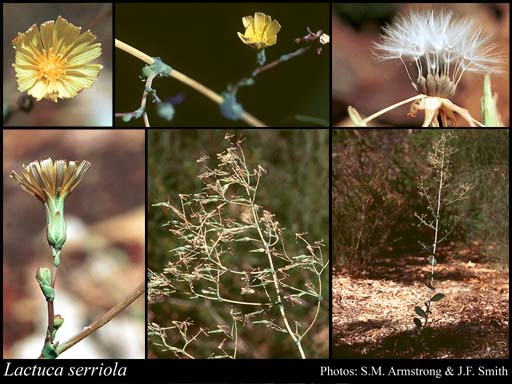- Reference
- Cent.Pl. II:29 (1756)
- Conservation Code
- Not threatened
- Naturalised Status
- Alien to Western Australia
- Name Status
- Current
Erect annual or biennial, herb, 0.4-2 m high. Fl. yellow, Oct to Dec or Jan to Feb. Roadsides, gardens, cultivated fields, disturbed sites.

Distribution
- IBRA Regions
- Avon Wheatbelt, Carnarvon, Coolgardie, Esperance Plains, Jarrah Forest, Mallee, Murchison, Pilbara, Swan Coastal Plain, Warren.
- IBRA Subregions
- Cape Range, Dandaragan Plateau, Eastern Goldfield, Eastern Murchison, Fitzgerald, Hamersley, Katanning, Mardabilla, Merredin, Northern Jarrah Forest, Perth, Southern Cross, Southern Jarrah Forest, Warren, Western Mallee, Western Murchison, Wooramel.
- IMCRA Regions
- Central West Coast, Leeuwin-Naturaliste.
- Local Government Areas (LGAs)
- Armadale, Ashburton, Bassendean, Boddington, Bridgetown-Greenbushes, Bruce Rock, Bunbury, Canning, Carnarvon, Dandaragan, Donnybrook-Balingup, Dundas, East Pilbara, Gingin, Harvey, Joondalup, Kalamunda, Kalgoorlie-Boulder, Kondinin, Leonora, Manjimup, Meekatharra, Mukinbudin, Mundaring, Murray, Narrogin, Peppermint Grove, Perth, Ravensthorpe, Rockingham, South Perth, Stirling, Swan, Tammin, Three Springs, Wanneroo, Waroona, Wyalkatchem, Yilgarn, York.
Management Notes (for the Swan NRM Region)
Alternative Names. Wild Lettuce, Compass Plant.
General Biology. Growth form. Herb. Life form. Annual. Reproduction. Seed. Dispersal. Wind, water, soil movement. Toxicity. Possibly poisonous to mammals. Seedbank persistence. Short term, 1-3 years. Fire response. Can increase in abundance in suitable post-fire conditions.
Notes. Can be biennial or a winter or summer annual. Colonises a range of disturbed habitats including wetlands. Exudes a white milky sap when damaged. Most seedlings emerge in autumn, grow slowly and form a rosette over winter, and then develop stems in spring. Long, warm autumns favour emergence and rosette establishment, and often result in large populations the following year. Plants emerging in spring have a shorter rosette phase before flowering and are often smaller than plants emerging in autumn.Seeds have an attached pappus for wind-dispersal, have no primary dormancy and only form a short term soil seedbank. Seed production is proportional to plant height, with taller plants able to produce as many as 2,300 seeds. Research has shown it has broadened its ecological amplitude, enabling it to invade a range of vegetation types. Many populations in southern Australia have developed resistance to Group 2 herbicides.
Additional information. Origin. Eurasia, North Africa. History of use/introduction. Genetic resources (primary genetic relative of lettuce), ornamental, medicines.
Suggested method of management and control. Manually remove small and/or isolated infestations, ensuring entire plant is removed especially the taproot. Apply glyphosate at early growth or rosette stages in spring, summer or autumn or metsulfuron methyl 5 g/ha (based on a minimum of 50 L/ha of water) + surfactant. Plants are difficult to control with herbicides once the flowering stems have begun to elongate. Read the manufacturers' labels and material safety data sheets before using herbicides. For further information consult the Australian Pesticides and Veterinary Medicines Authority to determine the status of permits for your situation or state.
Management Calendar
| Calendar Type | Jan | Feb | Mar | Apr | May | Jun | Jul | Aug | Sep | Oct | Nov | Dec | Comments |
|---|---|---|---|---|---|---|---|---|---|---|---|---|---|
| Germination | O | Y | Y | Y | Y | O | O | O | |||||
| Active Growth | Y | Y | O | O | O | O | Y | Y | Y | Y | |||
| Flowering | Y | Y | O | Y | Y | Y | |||||||
| Fruiting | Y | Y | Y | ||||||||||
| Manual Removal | Y | Y | Y | Y | Y | Y | Y | Y | |||||
| Herbicide Treatment | O | O | O | Y | Y | Y | O |
Legend: Y = Yes, regularly, O = Occasionally, U = Uncertain, referred by others but not confirmed.
References
- Brown, K. & Brooks, K. (2002) Bushland Weeds: A Practical Guide to their Management. Environmental Weeds Action Network, Greenwood.
- Burke, I.C., Yenish, J.P., Pittman, D. & Gallagher, R.S. (2009) Resistance of a Prickly Lettuce (Lactuca serriola) biotype to 2,4-D. Weed Technology, 23 (4): 586–591.
- Crawford, J.A., Wahren, C.H.A., Kyle, S. & Moir, W.H. (2001) Responses of exotic plant species to fires in Pinus ponderosa forests in northern Arizona. Journal of Vegetation Science, 12 (2): 261-268.
- Harden, G.J. (ed.) (1990-93) Flora of New South Wales Vols. 1 to 4. New South Wales University Press, Kensington.
- Hooftman, D.A.P., Oostermeijer, J.G.B. & den Nijs, J.C.M. (2006) Invasive behaviour of Lactuca serriola (Asteraceae) in the Netherlands: Spatial distribution and ecological amplitude. Basic and Apllied Ecology, 7: 507-519.
- Hussey, B.M.J., Keighery, G.J., Dodd, J., Lloyd, S.G. & Cousens, R.D. (2007) Western Weeds. A guide to the weeds of Western Australia. 2nd Edition. The Plant Protection Society of Western Australia, Victoria Park.
- Keeley, J.E., Baer-Keeley, M. & Fotheringham, C.J. (2005) Alien plant dynamics following fire in Mediterranean-climate California. Ecological Applications, 15 (6): 2109-2125.
- Mikulka, J. & Chodova, D. (2003) Germination and emergence of prickly lettuce (Lactuca serriola L.) and its susceptibility to selected herbicides. Plant Soil Environment, 49 (2): 89-94.
- Parsons, J.M. (ed.) (1995) The Australian weed control handbook. 10th Edition. Inkata Press, Melbourne.
- Prince, S.D. & Carter, R.N. (1985) The geographical distribution of prickly lettuce (Lactuca serriola). Journal of Ecology, 73: 49-64.
- United States Department of Agriculture (2001) The Plants Database, Version 3.1. URL: http://plants.usda.gov - Accessed December 2007. National Plant Data Center, Baton Rouge, LA 70874-4490 USA.
- Weaver, S.E. & Downs, M.P. (2003) The biology of Candian weeds. 122. Lactuca serriola L. Canadian Journal of Plant Science, 83: 619-628.
- Weavera, S., Cluney, K., Downs, M. & Paged, E. (2006) Prickly lettuce (Lactuca serriola) interference and seed production in soybeans and winter wheat. Weed Science, 54 (3): 496-503.